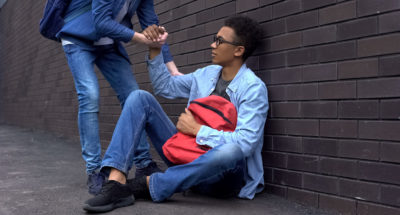
Why Do Good People Do Bad Things?
Students learn about what science has discovered about why good people don’t stand up for those being harmed; they then explore and practice what it means to be an upstander.

Students learn about what science has discovered about why good people don’t stand up for those being harmed; they then explore and practice what it means to be an upstander.
Students will:
Reflect on a time when you stood up for someone who was being bullied or harmed. How did it feel before, during, and after the incident? What inner resources or other factors encouraged you to stand up? What advice would you give for encouraging someone to be an upstander?
Note: The instructions below refer to the slides in this PowerPoint of lessons from Jubilee Centre for Character and Virtues.
Secondary Programme of Study was originally developed by the Jubilee Centre for Character and Virtue, in partnership with the John Templeton Foundation.
The Jubilee Centre is a pioneering interdisciplinary research centre focussing on character, virtues, and values in the interest of human flourishing, based at the University of Birmingham. The Centre is a leading informant on policy and practice in this area, and through its extensive range of projects contributes to a renewal of character virtues in both individuals and societies. In addition to the Secondary Programme of Study linked above, a full suite of free teaching resources can be accessed here: https://www.jubileecentre.ac.uk/432/character-education
How did students respond to this practice? Did their understanding of why people choose to be either bystanders or upstanders deepen?
The “bystander effect” occurs when being in the presence of other people keeps an individual from helping someone in need. According to numerous studies since the 1960s, this effect is evoked by three factors: 1) diffusion of responsibility or feeling less responsibility for helping when others are nearby, 2) pluralistic ignorance or believing that the help needed is not an emergency because others are not helping, and 3) evaluation apprehension or the fear of being judged by others when helping.
A more recent neurological study found that the bystander effect is even more complex than originally thought. Indeed, findings suggest that other factors play a role, such as a person’s ability to regulate the distressing emotions that occur when seeing someone in need of help, their perspective-taking skills when considering the experiences of both the person suffering and other bystanders, and finally their beliefs about whether they are capable of helping.
Helping others in need is a major part of life and something that students can learn to do early on. Growing their awareness of why they might not step up to help someone in a group situation—such as watching a student being bullied—may help them to overcome the internal and external barriers that keep them from reaching out.
In addition to practices such as this one, teaching students mindfulness and emotion skills can also cultivate their ability to overcome personal distress when seeing someone suffer, making them more likely to offer service.

Do you want to dive deeper into the science behind our GGIE practices? Enroll in one of our online courses for educators!
Comments